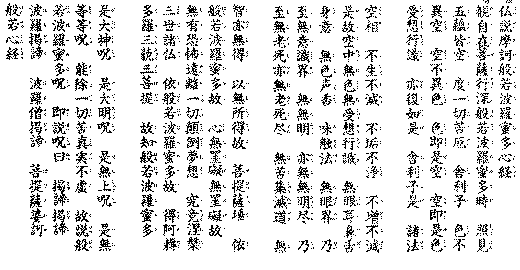Diamond Sangha
Sesshin Sutra Book
December 1991 version
Translations/revisions by Robert Aitken Roshi
of the Diamond Sangha Zen Buddhist Society,
Koko An, 2119 Kaloa Way, Honolulu, Hawaii, USA 96822
Sutras, literally the "warp" of the Dharma, are sermons of the Buddha, those attributed to him, and by limited extension, those of his successors.
MAKA HANNYA HARAMITA SHIN GYÔ
THE GREAT PRAJÑÂ PARAMITÂ HEART SÛTRA

The classical condensation of the six-hundred-volume Prajna Praramita literature, translated into Chinese by Hsuan-tang in the seventh century, can be called the basic Mahayana sutra. Known as the "Heart Sutra," it is recited in early morning services on ordinary days, and during the morning services at sesshin.
KAN JI ZAI BO SA GYÔ JIN HAN-NYA HA RA MI TA JI
Avalokiteshvara Bodhisattva, practicing deep Prajna Paramita,
SHÔ KEN GO ON KAI KÛ DO IS-SAI KU YAKU.
clearly saw that all five skandhasa
are empty, transforming anguish and distress.
SHA RI SHI SHIKI FU I KU KU FU I SHIKI
Shariputra, form is no other than emptiness, emptiness
no other than form;
SHIKI SOKU ZE KU KU SOKU ZE SHIKI
form is exactly emptiness, emptiness exactly form;
JÛ SÔ GYÔ SHIKI YAKU BU NYO ZE
sensation, perception, mental reaction, consciousness are
also like this.
SHA RI SHI ZE SHÔ HÔ KÛ SÔ FU SHÔ FU METSU
Shariputra, all things are essentially empty-- not born,
not destroyed;
FU KU FU JÔ FU ZÔ FU GEN
not stained, not pure; without loss, without gain.
ZE KO KÛ CHÛ MU SHIKI MU JU SÔ GYÔ SHIKI
Therefore in emptiness there is no form, no sensation,
perception, mental reaction, consciousness;
MU GEN-NI BI ZES-SHIN I
no eye, ear, nose, tongue, body, mind,
MU SHIKI SHÔ KÔ MI SOKU HÔ
no color, sound, smell, taste, touch, object of thought;
MU GEN KAI NAI SHI MU I SHIKI KAI
no seeing and so on to no thinking;b
MU MU MYÔ YAKU MU MU MYÔ JIN
no ignorance and also no ending of ignorance,
NAI SHI MU RÔ SHI YAKU MU RÔ SHI JIN
and so on to no old age and death, and also no ending of
old age and death;c
MU KU SHU METSU DÔ
no anguish, cause of anguish, cessation, path;d
MU CHI YAKU MU TOKU I MU SHÔ TOK'KO
no wisdom and no attainment. Since there is nothing to
attain,
BO DAI SAT-TA E HAN-NYA HA RA MI TA
the Bodhisattva lives by Prajna Paramita,
KO SHIM-MU KEI GE MU KEI GE KO MU U KU FU
with no hindrance in the mind; no hindrance and therefore
no fear;
ON RI IS-SAI TEN DÔ MU SÔ KU GYÔ NE HAN
far beyond delusive thinking, right here is Nirvana.
SAN ZE SHÔ BUTSU E HAN-NYA HA RA MI TA KO
All Buddhas of past, present, and future live by Prajna
Paramita
TOKU A NOKU TA RA SAM-MYAKU SAM-BO DAI
attaining Anuttara-samyak-sambodhi.e
KO CHI HAN-NYA HA RA MI TA
Therefore know that Prajna Paramita
ZE DAI JIN SHÛ ZE DAI MYÔ SHÛ
is the great sacred mantra, the great vivid mantra,
ZE MU JÔ SHÛ ZE MU TO TO SHÛ
the unsurpassed mantra, the supreme mantra,
NO JÔ IS-SAI KU SHIN JITSU FU KO
which completely removes all anguish. This is truth not
mere formality.
KO SETSU HAN-MYA HA RA MI TA SHU
Therefore set forth the Prajna Paramita mantra,
SOKU SETSU SHU WATSU
set forth this mantra and proclaim:
GYA TEI GYA TEI HA RA GYA TEI HARA SO GYA TEI
Gate gate paragate parasamgatef
BO JI SOWA KA HAN-NYA SHIN GYÔ
Bodhi svaha!g
Notes and comments are lifted from the endnotes of the Empty Sky compilation of these Zen Buddhist texts and The Syllabus section of Encouraging Words - zen buddhist teachings for western students by Robert Aitken Roshi
a Skandhas
the five "bundles" that make up the self: forms of the world,
sensation, perception, mental reaction and consciousness.
b
The six senses, the six fields sensed and the six qualities of consciousness
(seeing, hearing, smelling, tasting, feeling & thinking) form the
Eighteen Dhatus, or differentiated categories.
c
Refers to the Twelve-linked
Chain of Causation (12 nidannas) The classical karmic cycle. With no
liberation from this chain, it is endlessly repeated.
d
The Four Noble Truths
1.
Anguish is everywhere.
2. There is a cause of anguish.
3. There is liberation from anguish,
4. Liberation from anguish is the Eightfold Path.
e
(Sanskrit) Supreme perfect, all-penetrating
enlightenment. Total unitive fulfillment.
f
DT Suzuki translates as "Gone, gone,
gone to the other shore, landed at the other shore."
g
Exclamation of joy.
The ascii version of these texts can be acquired from the Electronic Buddhist Archives section of the Coombspapers Social Sciences Research Data Bank

